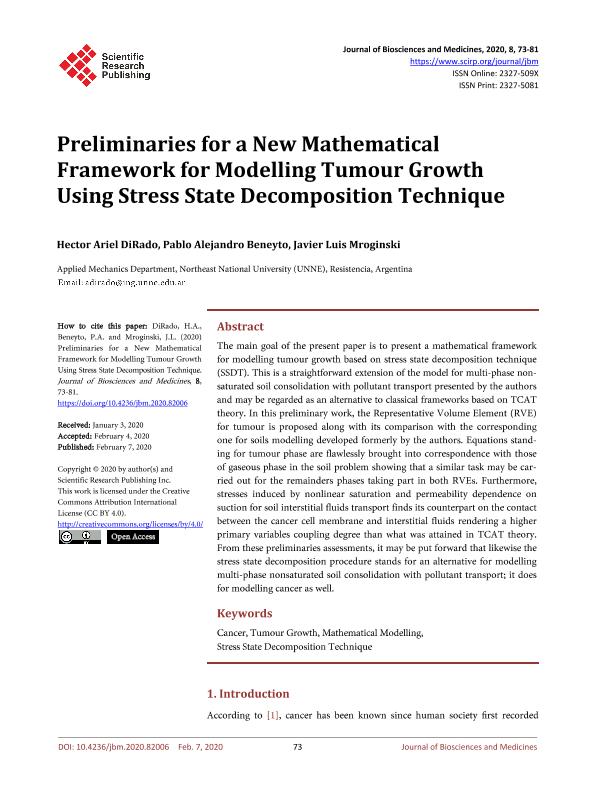Mostrar el registro sencillo del ítem
dc.contributor.author
Di Rado, Hector Ariel

dc.contributor.author
Beneyto, Pablo Alejandro

dc.contributor.author
Mroginski, Javier Luis

dc.date.available
2022-03-03T11:47:50Z
dc.date.issued
2020-02
dc.identifier.citation
Di Rado, Hector Ariel; Beneyto, Pablo Alejandro; Mroginski, Javier Luis; Preliminaries for a new mathematical framework for modelling tumour growth
using stress state decomposition technique; Scientific Research Publishing; Journal of Biosciences and Medicines; 08; 02; 2-2020; 73-81
dc.identifier.issn
2327-5081
dc.identifier.uri
http://hdl.handle.net/11336/152817
dc.description.abstract
The main goal of the present paper is to present a mathematical framework for modelling tumour growth based on stress state decomposition technique (SSDT). This is a straightforward extension of the model for multi-phase non-saturated soil consolidation with pollutant transport presented by the authors and may be regarded as an alternative to classical frameworks based on TCAT theory. In this preliminary work, the Representative Volume Element (RVE) for tumour is proposed along with its comparison with the corresponding one for soils modelling developed formerly by the authors. Equations standing for tumour phase are flawlessly brought into correspondence with those of gaseous phase in the soil problem showing that a similar task may be carried out for the remainders phases taking part in both RVEs. Furthermore, stresses induced by nonlinear saturation and permeability dependence on suction for soil interstitial fluids transport finds its counterpart on the contact between the cancer cell membrane and interstitial fluids rendering a higher primary variables coupling degree than what was attained in TCAT theory. From these preliminaries assessments, it may be put forward that likewise the stress state decomposition procedure stands for an alternative for modelling multi-phase nonsaturated soil consolidation with pollutant transport; it does for modelling cancer as well.
dc.format
application/pdf
dc.language.iso
eng
dc.publisher
Scientific Research Publishing
dc.rights
info:eu-repo/semantics/openAccess
dc.rights.uri
https://creativecommons.org/licenses/by/2.5/ar/
dc.subject
CANCER
dc.subject
TUMOUR GROWTH
dc.subject
MATHEMATICAL MODELLING
dc.subject
STRESS STATE DECOMPOSITION TECHNIQUE
dc.subject.classification
Tecnologías que involucran la manipulación de células, tejidos, órganos o todo el organismo

dc.subject.classification
Biotecnología de la Salud

dc.subject.classification
CIENCIAS MÉDICAS Y DE LA SALUD

dc.title
Preliminaries for a new mathematical framework for modelling tumour growth
using stress state decomposition technique
dc.type
info:eu-repo/semantics/article
dc.type
info:ar-repo/semantics/artículo
dc.type
info:eu-repo/semantics/publishedVersion
dc.date.updated
2022-01-20T13:09:33Z
dc.identifier.eissn
2327-509X
dc.journal.volume
08
dc.journal.number
02
dc.journal.pagination
73-81
dc.journal.pais
Estados Unidos

dc.description.fil
Fil: Di Rado, Hector Ariel. Universidad Nacional del Nordeste. Facultad de Ingeniería; Argentina
dc.description.fil
Fil: Beneyto, Pablo Alejandro. Universidad Nacional del Nordeste. Facultad de Ingeniería; Argentina. Consejo Nacional de Investigaciones Científicas y Técnicas. Centro Científico Tecnológico Conicet - Nordeste. Instituto de Modelado e Innovación Tecnológica. Universidad Nacional del Nordeste. Facultad de Ciencias Exactas Naturales y Agrimensura. Instituto de Modelado e Innovación Tecnológica; Argentina
dc.description.fil
Fil: Mroginski, Javier Luis. Universidad Nacional del Nordeste. Facultad de Ingeniería; Argentina. Consejo Nacional de Investigaciones Científicas y Técnicas. Centro Científico Tecnológico Conicet - Nordeste; Argentina
dc.journal.title
Journal of Biosciences and Medicines
dc.relation.alternativeid
info:eu-repo/semantics/altIdentifier/doi/http://dx.doi.org/10.4236/jbm.2020.82006
dc.relation.alternativeid
info:eu-repo/semantics/altIdentifier/url/https://www.scirp.org/journal/paperinformation.aspx?paperid=98166
Archivos asociados
